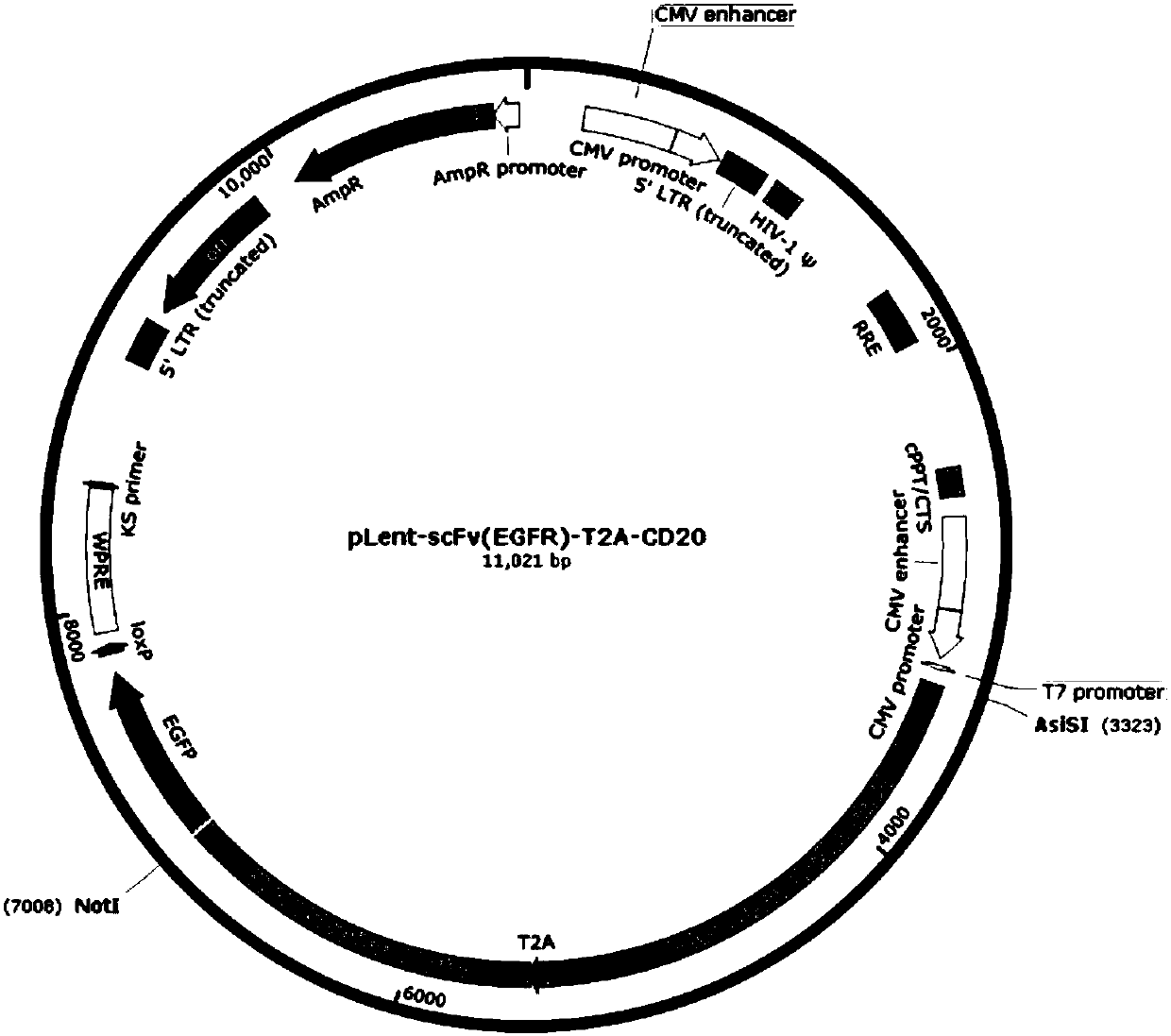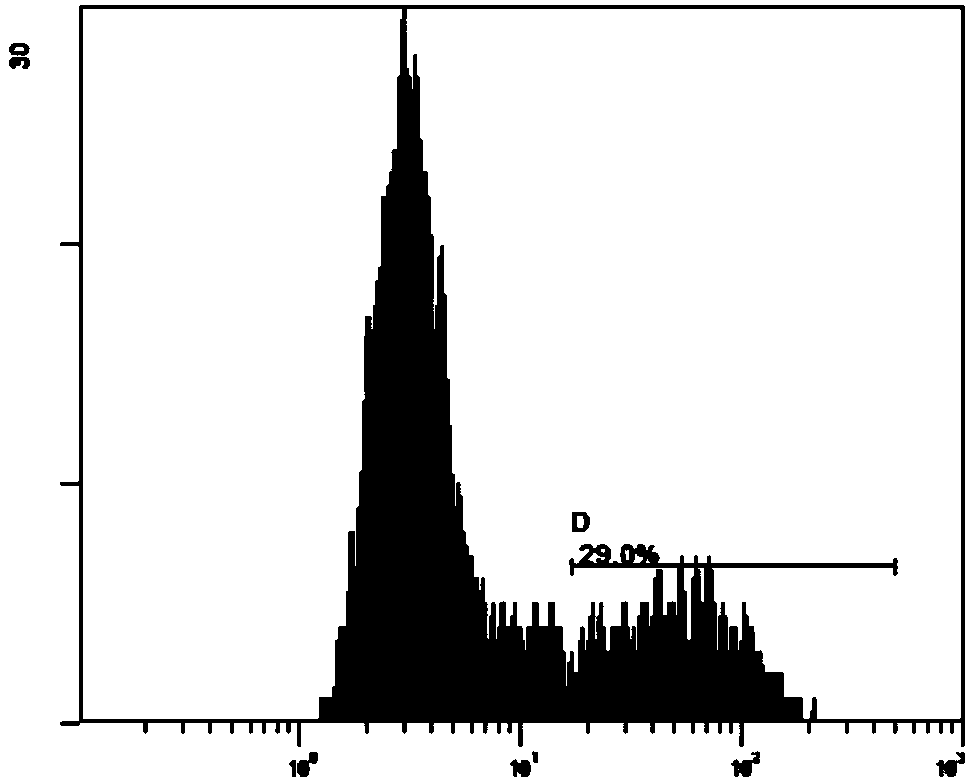Method for preparing anti-EGFR safe chimeric antigen receptor modified immune cell and application thereof
A chimeric antigen receptor and immune cell technology, applied in the field of immune cell preparation, can solve the problems of false attack of tissue cells, cytokine storm, etc., and achieve the effects of controlling toxic side effects, improving safety, and avoiding adverse reactions
- Summary
- Abstract
- Description
- Claims
- Application Information
AI Technical Summary
Problems solved by technology
Method used
Image
Examples
Embodiment 1
[0025] Embodiment 1: the fusion gene fragment scFv (EGFR)-CD8-CD137-CD3ζ-T2A-Leader-CD20-CD8-CD3ζ is inserted into the lentiviral expression vector pLent-C-GFP
[0026] Anti-EGFR CAR module comments figure 1 (See appendix SEQ ID NO.1 for the nucleic acid sequence).
[0027] The sequence of each module of CAR of Anti-EGFR
[0028] (1) CD20 nucleic acid artificial sequence (SEQ ID NO.2)
[0029] (2) Linker nucleic acid artificial sequence (SEQ ID NO.3)
[0030] (3) T2A nucleic acid artificial sequence (SEQ ID NO.4)
[0031] (4) CAR leader sequence (Leader) nucleic acid artificial sequence (SEQ ID NO.5)
[0032] (5) Anti-EGFR single chain Fv antibody nucleic acid artificial sequence (SEQ ID NO.6)
[0033] (6) CD8 Hinge region nucleic acid artificial sequence (SEQ ID NO.7)
[0034] (7) CD8 transmembrane region nucleic acid artificial sequence (SEQ ID NO.8)
[0035] (8) CD137 intracellular nucleic acid artificial sequence (SEQ ID NO.9)
[0036] (9) CD3ζ intracellular region...
Embodiment 2
[0038] Embodiment 2: lentivirus packaging, virus titer detection
[0039] Inoculate the cell line 293T in a 10 cm dish containing DMEM+10% FBS at 37°C, 5% CO 2 Cultured under conditions, the adherence rate is 70%-80%, and then used for lentivirus transfection. Recombinant plasmid pLent-scFv(EGFR)-T2A-CD20 and empty plasmid pLent-C-GFP were co-transfected with lentiviral packaging plasmid into 293T cells by calcium phosphate transfection method. For specific methods, refer to molecular cloning. 24 hours after transfection, the cells were obviously enlarged and spherical, and their ability to adhere to the wall decreased and they were easy to fall off. After 48 hours, the expression of green fluorescent protein in the cells was observed under an inverted fluorescence microscope. After 72 hours, collect the supernatant into an EP tube, centrifuge at 2000 g for 10 min, transfer to a new EP tube, filter through a 4.5 μm filter, and store the virus solution at -80°C. According to...
Embodiment 3
[0040] Example 3 Lentivirus Infection of CIK Cells and Expansion and Culture of CIK Cells after Infection
[0041] Infect CIK cells with the above-mentioned recombinant lentivirus, incubate the infected cells in a 37°C, 5% CO2 incubator for 8 hours, collect the cells, add virus solution again, 1000g, centrifuge for 90 minutes, and culture at 37°C, 5% CO2 Continue to culture in the box, so repeated multiple infection, improve the infection efficiency of CIK cells. Aspirate 2ml of the culture supernatant, add 2ml of fresh medium, continue to expand the culture, and culture for 17 days until the cells are expanded to a sufficient amount. The chimeric antigen receptor expression was detected by the FLTC (isothiocyanate) channel of the FC500 flow cytometer. Taking uninfected CIK lymphocytes as a negative control, the positive rate of CIK cells infected by recombinant lentivirus was 29.0% ( image 3 ).
PUM
 Login to View More
Login to View More Abstract
Description
Claims
Application Information
 Login to View More
Login to View More - R&D
- Intellectual Property
- Life Sciences
- Materials
- Tech Scout
- Unparalleled Data Quality
- Higher Quality Content
- 60% Fewer Hallucinations
Browse by: Latest US Patents, China's latest patents, Technical Efficacy Thesaurus, Application Domain, Technology Topic, Popular Technical Reports.
© 2025 PatSnap. All rights reserved.Legal|Privacy policy|Modern Slavery Act Transparency Statement|Sitemap|About US| Contact US: help@patsnap.com



